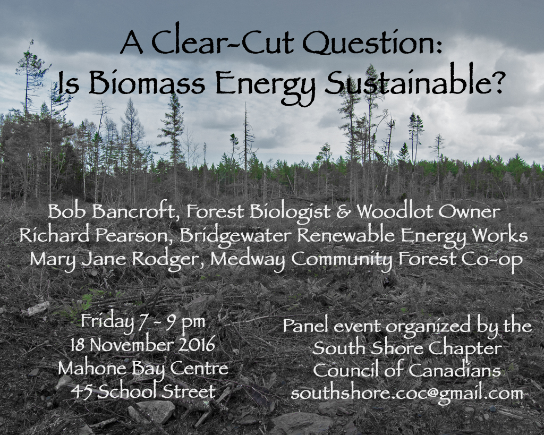|
Chatham House, the Royal Institute on International Affairs, recently published an article by Duncan Brack, whom they describe as "an independent environmental policy analyst, an associate fellow of Chatham House and an associate of Forest Trends. From 2010 to 2012 he was special adviser at the UK Department of Energy and Climate Change; before that he worked for Chatham House, and from 1998 to 2003 was head of its Sustainable Development Programme. His areas of expertise include international forestry policy, forest governance and the timber trade, climate policy, low-carbon investment, bioenergy, public procurement, the interaction between environmental regulation and trade rules, ozone depletion and the Montreal Protocol, and international environmental crime, particularly illegal logging and the trade in illegal timber."
0 Comments
(published in the The Halifax Herald 03/04/2017)
NOVA SCOTIA FORESTRY: Don’t listen to industry reassurances Public losing confidence in government role in forestry by MIKE PARKER I conceive that the land belongs to a vast family of which many are dead, few are living and countless numbers are still unborn. — Anonymous Whenever we, the public, question questionable forestry practices, government and industry invariably respond with talking points straight from The Clear-Cutters’ and Whole Tree Harvesters’ Biomass Thesaurus of Alternative-Facts. Think of the times you have been told professionals are "applying best practices and science to forest management." Or that professionals "harvest our forests and they grow back, healthier and more productive and more sustainable than they were before." And who can forget this top contender for quote of the year? "The forest is more than a resource to us. It’s a legacy for Nova Scotians and we are the proud stewards." Really? If this doesn’t work, then pulpit theatrics are ramped up: "Pessimists in Nova Scotia are still in abundance, standing in front of every industry they perceive as not fitting their narrow vision for our resources, preaching the "No" in Nova Scotia." Should that fail, spin doctors play the Trump card: "In the press there appears to be a persistent anti-forestry-resource-management bias." Not being a professional forester, I have been sloughed off in the past by the self-appointed stewards- of-the-woods as being critical, rhetorical, holier-than-thou and, the deepest cut of all, a "retiree", which I can only guess means I am old and as such my opinions are based in senility and not fact. With what fading faculties remain, I searched out a respected voice who can speak to forestry issues in Nova Scotia. I found it in the person of Dr. Jack Ward Thomas (1934-2016), a renowned American ecologist, Boone and Crockett Professor of Wildlife Conservation in the School of Forestry at the University of Montana, and thirteenth chief of the U.S. Forest Service. In 2001, Dr. Thomas presented a paper at the University of Alberta entitled Are There Lessons for Canadian Foresters Lurking South of the Border? It was based upon the successful campaign American environmentalists had recently waged against the "resource extraction community" in stopping overcutting in the national forests, aka public lands, or as we know them here, Crown lands. "Foresters were too certain of their positions of prestige and authority and, evidently, felt themselves above the messy realities of functioning over the long term in a democracy," Dr. Thomas wrote. "In the end, there are professional prerogatives that will not exist unless sanctioned by the people at large." He argued that foresters began "to do things that we had not done before (at least not at large scale) — including things that foresters themselves had, in an earlier period, coached the public to consider the personification of careless greed." "Foremost among these was the increasing practice of even-aged forest management embodying clear-cutting," he observed. And "a view from the sky revealed an ever-increasing network of roads connecting a patchwork of clear cuts." Dr. Thomas also argued that clear-cutting was "coupled with the decision, driven by considerations of economic efficiency . . . to convert ‘decadent, stagnate, biological deserts’ of late-successional (‘old-growth’) forests to young, vigorous, fast-growing, forests — often of selected single species." "These stands — or at least many of them — were, then, to be managed in a semi-agricultural fashion to maximize growth on selected trees to yield maximal economic benefits . . ." "So far as wildlife and fish were concerned," he wrote, "the forester’s mantra was, far too often, that ‘good forestry is good wildlife management.’ . . . Foresters clung tenaciously to that adage long after the emerging science clearly showed otherwise . . . Retention of biodiversity became a concern and foresters were forced to modify their objectives, and management, to deal with threatened or endangered species." Any of this sound familiar? There’s more. Dr. Thomas spoke of lessons that emerge: "Once the citizens of a democracy realize that they — in the final analysis — are the owners of the public lands, they will seek an increasing role in the management of those lands. Further, if the concerns of these citizens are ‘blown off ’ by professional land managers and politicians, they will respond by organizing to magnify their political impact . . ." Indeed, he warned that "foresters’ reputations have declined as a result of hanging on too long to models of management predicated on the application of ‘industrial strength forestry’ on both public and private lands. The myth of the omniscient forester as the complete natural resource manager is obsolete." "Forcing the application of economics based models to the exclusion of interests in biodiversity preservation, aesthetics, fish and wildlife, etc., will produce a backlash from the public." Here are other lessons Dr. Thomas’s paper offers us: • "Close relationships, if perceived of as too close, between industry and government related to exploitation of public lands can engender resentment and backlash." • "Perceived subsidies of industry’s extraction of wood from public lands will be increasingly questioned by an increasingly sensitive public." • "There is a rising ‘green movement’ in all western democracies that is likely to grow as we come more and more to face with a finite land base." • Foresters can "try to ignore the (public) or at least, marginalize their impact through political machination or accept the legitimacy of their concerns and their rights to be concerned and politically active. In the first course of action lies an increasingly contentious battle with significant defeat, with related loss of prestige and authority, a distinct possibility — even a probability. In the second course of action lies some opportunity to heed the age-old admonition, ‘Come, let us reason together’ and come to reasoned adjustments in management practices thereby heading off intensified conflict . . . " Dr. Thomas closed his analysis with these words of caution: "Accidents . . . lie ahead on the road called forest management unless you alter course. Heads up." Are you listening Premier Stephen McNeil, Natural Resources Minister Lloyd Hines, Nova Scotia MLAs? Stand up, speak up Nova Scotia. May the forest be with you and yours. Mike Parker has been researching, writing and talking about! the history and heritage of Nova Scotia's woods and waters for 30 years. His book, Nebooktook In the Woods, addresses his concerns about forestry practices in the province. His Facebook page, Woods and Waters Nova Scotia, has more information on Dr. Jack Ward Thomas. Michael Gorman has posted a brilliant item on radio, tv and the net. Check it out here. As dealt with elsewhere on this blog, in Jack Pine's Forest Notes, and all over the press and media, the Nova Scotia Department of Natural Resources, ignoring thousands of volunteer hours donated by Nova Scotians like you and me, had the audacity to axe the province's Natural Resource Strategy including and especially one key fundamental: It was agreed we would reduce clearcutting to no more than 50% of our total harvest. Last summer, while everyone was at the beach, they deep-sixed that goal, indeed basically chucked the whole Strategy. Then they signed away management of ALL the Crown land in Western Nova Scotia, 1.4 million acres, to a consortium of 13 mills, the largest of which are huge non-Nova Scotian companies. If you can figure out DNR's hopelessly complex Harvest Maps and, though unpaid and probably not a licensed forester, in 20 days you can formulate a sufficiently articulate argument to counter to their planned harvest, who do you hear back from? DNR? No. WestFor, of course. Check out their website - they are custodians of the harvest maps. Though we Nova Scotians spent $111m to "Buy Back the Mersey" to turn the corner on rapacious harvest methods, who's in charge now? Not you. Not me. The mills. Are they harvesting quick and dirty to feed their corporate bottom lines, buzzing off vast swaths of the province, or are they stewarding our asset intelligently, allowing the trees to grow, increase in value, provide millions of dollars of natural ecological services? According to Gorman's piece, they're adding insult to injury hiring out of province workers to cut down our birthright. So much for jobs, jobs, jobs. It's been argued that 10% of our provincial debt has gone to prop up this highly touted industry. Ladies and gentlemen, this is a raw deal. It is time to speak out!
Behind closed doors, Nova Scotia’s Department of Natural Resources has quietly transferred the management of 1.4 million acres of Crown lands to WestFor, a consortium of 13 privately owned mills. Some of these mills are local companies with a long history in their communities (Turner, Ledwidge, Freeman), others are decidedly international (Northern Pulp, Louisiana Pacific). All answer to their owners or stockholders, not to the public. They are managing our crown land for their profit and the sustainability of their companies, nothing else. The allocation of Western Crown to WestFor is the largest allocation ever made in Nova Scotia. When a citizen sends an inquiry about planned harvests through DNR’s Harvest Map Viewer, a response comes back from someone who works for WestFor, not from a government employee. WestFor’s management of our crown lands may soon be solidified by a 10-year lease.
Nova Scotians need to ask themselves: should private industry be the steward of public lands? Should the fox look after the hen house? Should the foxes be allowed to work together to decimate the hens? Not long ago, Nova Scotians fought long and hard to convince the government to “Buy Back the Mersey”. The massive tracts that had belonged to Bowater Mersey became part of our Crown lands with a net cost to taxpayers of $111 million. Nova Scotians thought that these lands would be managed for the benefit of all citizens, not for the monetary benefit of a few companies. Changes in forest management strategies were promised, particularly when the Natural Resources Strategy was implemented 6 years ago. A few changes have been made: the type of forest is assessed before the type of harvest is decided, but somehow the vast majority of harvests turn out to be clear cuts. Giving WestFor a 10-year lease to manage 1.4 million acres of Crown lands would give industry unprecedented access to public forests. It would tip the scales towards devastating industrial exploitation, with virtually no consideration for ecological and environmental values. Perhaps the public is not fully aware of the inroads industrial forestry has made into our Crown lands, but during the 25 years up to 2014, the last year of published forest data, 42% of the operable forest in Nova Scotia has been clear cut. Satellite photos taken from Global Forest Watch show an alarming loss of forest in much of central and northern Nova Scotia (see Jan 14th Chronicle Herald article by Crossland,). Instead of engaging the public with transparent consultations, DNR is allowing a consortium of mills to decide when, where and how to cut our forests. What oversight is given to the decisions? DNR should recognize that Nova Scotians want greater transparency and meaningful public consultation around the allocation of public resources. This arrangement with WestFor must not continue. Government needs to assure the sustainability of our forests for the well being of our and future generations.
The HFC has become aware of illegal tree poaching. Anybody out there hear of anything like that? If so, you can drop us a confidential line at info@healthyforestcoalition.ca or if you want to go public, feel free to reply in our comment section below.
According to a 2014 US study, if humans grew like trees, after adolescence our growth rate would accelerate geometrically. By the time we retire, we'd be big as King Kong.
So, with that kind of exponential potential occurring naturally in our forests, why do we keep cutting our trees younger and younger? Why do we insist on shorter and shorter rotations? Let 'em grow 40 or 50 years, then cut 'em down. Witness the dwindling size of logs on all those big trucks hustling up and down our highways, burning up fuel like there's no tomorrow. At this rate, there probably won't be. Check out the startling Global Forest Watch maps showing Nova Scotia's devastating forest loss over the last decade. We are stealing from future generations! Why? To feed a heavily subsidized industry (arguably 10% of the provincial debt), reeling under bank loans incurred to buy bigger and bigger machinery so they can increase efficiency and eliminate more and more jobs. Crazy. We clearcut our forests then have to start them all over again from scratch. So we're not just cutting trees. We're also cutting our noses to spite our faces. Why not let our mature trees grow, and harvest selectively? Why not shift the forest products industry to produce longer lasting value-added products, like hardwood flooring or laminated beams to replace steel in construction? Why not invest in the long term? Why not build employment and our rural economy by increasing the quality and quantity of our wood by working with nature instead of against her? And while we're at it, though Mr. Trump may disagree, let's not forget this planet's biggest, most immediate problem, climate change. The US study proves that bigger, older trees as befits their size sequester way more carbon than spindly young ones. We cut young trees, some for lumber or pulp, but the rest for biomass under the illusion we're creating green energy. You know what happens when you burn trees? Not only do you release whatever carbon dioxide they may have pulled out of the atmosphere, you also kill forever their ability to sequester any more carbon. It's a double whammy. So, let 'em grow and get bigger better wood, create jobs, help the economy, provide for future generations, and combat global warming, or cut 'em young, eliminate jobs, add to the provincial debt, and cut off at the knees the ability of our greatest renewable resource to fight climate change. That's our choice. Time to ask ourselves some serious questions and set some new directions. We could, for example:
Tree growth just gets going at adolescence. If only one could say the same for human intelligence. Sometimes it seems like ours grinds to a halt.
Published in Inverness Onan and reprinted in the Halifax Examiner, HFC supporter JIm Harpell writes:
Going through articles in the Chronicle Herald over the last couple of months written by either DNR officials or by others in the forestry industry, I am reminded of the well known literary quote, "Methinks thou [doth] protest too much." We had the minister, Lloyd Hines, Jeff Bishop, Cliff Drysdale, Kim Fuller, et al. expound profusely about the wonderful forest "management" strategy put forward by DNR and the forest corporations. They call their policies “science-based” yet, when asked to produce peer reviewed scientific evidence to back their policies, they are not forthcoming. Then, they revert to downplaying the expertise of those who oppose the way in which the industry is decimating the forests (with the blessing of those in the DNR). Also, they use the tactic of negatively labelling those opponents as did Mr. Eddy in Truro when he called those opposed to clearcutting “peacocks puffing themselves up for show” or Ms. Fuller calling them "pessimists standing in front of every industry they perceive as not fitting their narrow vision for our resources", or the Harper government calling them “environmental terrorists”. These people ignore the wealth of research on the other side done by scientists and forestry researchers from all over the world (peer reviewed and supported). They ignore the evidence of Global Forest Watch as to the level of destruction done to the forest when clearcutting has taken place. At recent meetings in the western part of the province and in Cape Breton, NASA slides showing clearly the difference in clearcutting from 2002 to 2014, were seen by people in both the DNR and the forestry industry. Yet, this is totally ignored. It is as if they closed their eyes when the slides were presented. Also, the supporters of the present "management strategies" never talk about how the forest floors are destroyed by the big machinery; how the wildlife is endangered; how the forests which replace the healthy forests are not of the same quality as that which has been lost; how the "regulations" restricting the cutting close to waterways are being ignored without penalty; or how the nutrients which formerly fed the new forests are now carted away to be used in biomass plants either here or overseas. A friend has compiled a 500 page book covering all these topics. The research he has compiled comes from all over the world. Personally, I have given the former minister of natural resources an 80 page paper on the dangers of biomass burning. I indicated to him that this paper by Dr. Mary Booth, an expert in the field, was extremely informative, but because I knew how busy he was, that if he read five pages which I wrote on the cover, he would see how terrible this practice is to the environment. Yet, nothing changed. The evidence is there to support our argument against clearcutting and all we need to do is to drive along any major highway to see the scrawny, low-quality forests which replace the old forests, (which, by the way, are far better at taking carbon out of the atmosphere and reseeding the surrounding areas). After a second clearcutting, the quality of the replacement forest is even lower. And these things we can see for ourselves. We don't need to listen to either side of the argument. We just need to be observant. Jim Harpell Shortt's Lake
We thought you might be interested in these slides from Global Forest Watch showing the province's forest loss over the period 2001 to 2014. Under the watchful eye of the Department of Natural Resources, see how well they are managing your forests...
The scientific basis of DNR’s Forest Management strategy has received considerable media attention recently. Mike Parker wrote an opinion piece in the Chronicle Herald with the central request that DNR show the science that supports its extensive use of clear cutting. In response, DNR’s Minister Hines explained that his staff is trained in a wide range of sciences, from geology to entomology. Trained scientists may work for DNR but do they carry out scientific studies, and more importantly, are their findings available as peer-reviewed publications? The obligatory validation of science comes through peer reviewed and openly accessible publication of findings. Freedom of information requests are not necessary in the world of scientific communication. Peer-reviewed publications are not the means by which DNR shares the conclusions, of its landscape level ecosystem management. No, the results of its deliberations are posted on the Harvest Viewer, a digital map of the province showing the next areas of crown land slated for clear cutting or partial cutting. The public is given a few weeks to respond, DNR may make some adjustments and then the harvest is set in stone. Landscape level, ecosystem management sounds impressive, but it has not been defined to the public in a systematic, transparent fashion. Scientific studies required to substantiate landscape level ecosystem management of forests would take decades to carry out, and nothing of the sort has been carried out by DNR. So where is the science carried out by the scientists working at DNR? To their credit, staff at DNR, including Peter Quigley, Kevin Keys and others, have done much careful work documenting the variety of forests and soil types in our province. Some of this was published in an informative guide “Forest System Classification for Nova Scotia” available as a government publication. This classification is used in pre-treatment assessments of lands targeted for harvesting. In September, Keys and co-authors published a study titled “A simple geospatial Nutrient Budget Model for Assessing Forest Harvest Sustainability across Nova Scotia, Canada” in the Open Journal of Forestry. The study concludes that existing data on soil nutrients is no longer accurate and that up to 50% of the plantation areas surveyed and assessed using their new model did not reach nutrient sustainability. Our poor soils suffer from deforestation and acid rain, preventing them from sustaining many cycles of intensive forestry. But intensive forestry is exactly what DNR is encouraging and permitting. The NS Code of Forestry Practice states “Extensive forest lands will be managed for resource production using techniques that mimic natural disturbances and sustain natural ecosystem structure and function.” Judging by recent harvest recommendations, DNR believes that all of Nova Scotia has natural disturbance regimes that eliminate all trees. Only catastrophic storms or glaciations cause the level of disturbance wrought by current forestry practices. Their own recently published work (Keys et al 2016) cautions against just such intensive harvests. To believe that current forestry practices in Nova Scotia are based on scientific studies is like believing in reality TV shows. To believe that these intensive forestry practices will sustain natural ecosystem structure and function is wishful thinking at best. - Dr. Helga Guderley Dr. Guderley, retired Biology Professor, Université Laval, Adjunct Professor at Université Laval and Dalhousie, physiologist, former President of the Canadian Society of Zoologists and Associate Editor of the Canadian Journal of Zoology, who has published more than 170 peer-reviewed papers and many book chapters, points out that Mr. Hines’ argument is seriously flawed. The most fundamental precept of good science is peer review, and the DNR’s so-called “science” is rarely subjected to this kind of independent third party scrutiny. Worse, the only way one can review the data DNR uses to decide harvest practices is by FOIPOP, resorting to the byzantine process of soliciting materials through the Freedom of Information Act. Government claims of transparency, Dr. Guderley points out, are bogus. |
Blog Archives
October 2020
Blog Index
All
|
Photo used under Creative Commons from DaveW99999














 RSS Feed
RSS Feed
